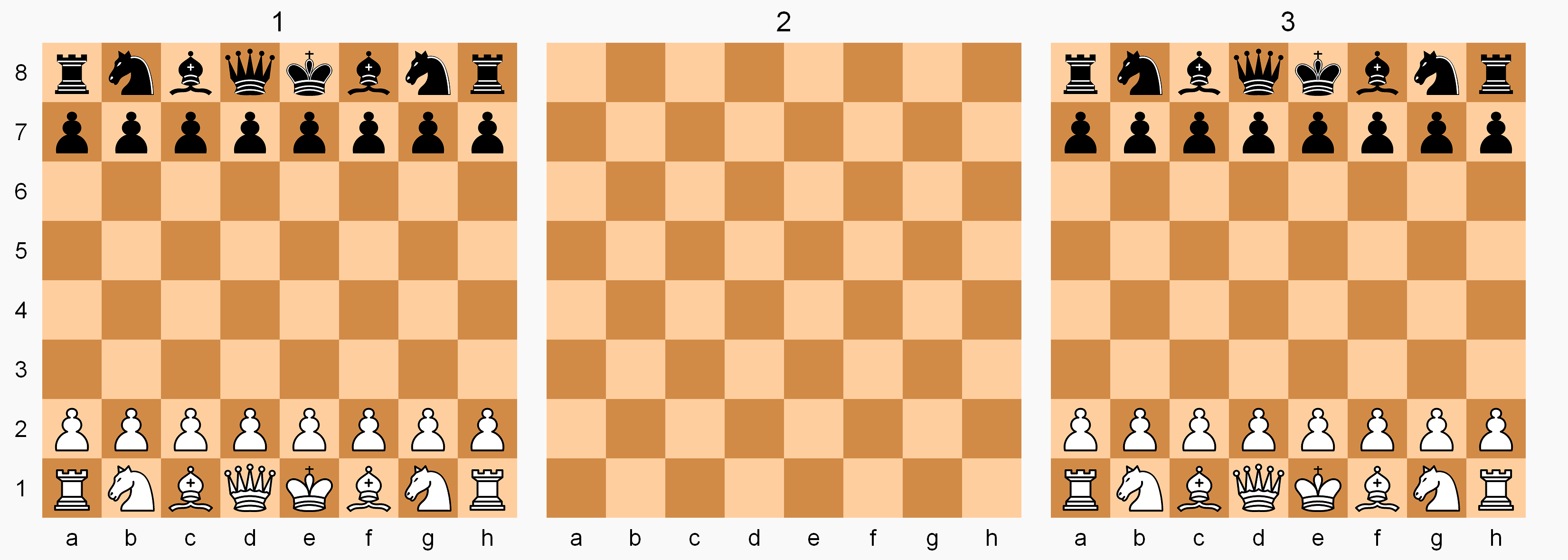 |
Three-dimensional Chess
Three-dimensional chess (or 3‑D chess) is any chess variant that replaces the two-dimensional chessboard, board with a three-dimensional array of cells between which the pieces can move. In practice, this is usually achieved by boards representing different layers being laid out next to each other. Three-dimensional chess has often appeared in science fiction—the ''Star Trek'' franchise in particular—contributing to the game's familiarity. Three-dimensional variants have existed since at least the late 19th century, one of the oldest being Raumschach (German for "Space chess"), invented in 1907 by Ferdinand Maack and considered the classic 3‑D game. Chapter 25 of David Pritchard (chess writer), David Pritchard's ''The Classified Encyclopedia of Chess Variants'' discusses some 50 such variations extending chess to three dimensions as well as a handful of higher-dimensional variants. Chapter 11 covers variants using multiple boards normally set side by side wh ... [...More Info...] [...Related Items...] OR: [Wikipedia] [Google] [Baidu] |
|
Kieseritzky Cubic Chess Board
Kieseritzy is the surname of several people: * Gustav Kieseritzky (1893–1943), highly decorated Vizeadmiral in the German Kriegsmarine during World War II * Lionel Kieseritzky (1806–1853), Baltic-German chess master and writer * R.K. Kieseritzky (c. 1870 – after 1923), Russian chess master ;Also * Boden-Kieseritzky Gambit, chess opening named for Samuel Standridge Boden and Lionel Kieseritzky * Kieseritzky Gambit, chess opening named for Lionel Kieseritzky {{surname ... [...More Info...] [...Related Items...] OR: [Wikipedia] [Google] [Baidu] |
|
|
Space Diagonal
In geometry, a space diagonal (also interior diagonal or body diagonal) of a polyhedron is a line connecting two vertices that are not on the same face. Space diagonals contrast with '' face diagonals'', which connect vertices on the same face (but not on the same edge) as each other. For example, a pyramid has no space diagonals, while a cube (shown at right) or more generally a parallelepiped has four space diagonals. Axial diagonal An axial diagonal is a space diagonal that passes through the center of a polyhedron. For example, in a cube with edge length ''a'', all four space diagonals are axial diagonals, of common length a\sqrt . More generally, a cuboid with edge lengths ''a'', ''b'', and ''c'' has all four space diagonals axial, with common length \sqrt. A regular octahedron has 3 axial diagonals, of length a\sqrt , with edge length ''a''. A regular icosahedron has 6 axial diagonals of length a\sqrt , where \varphi is the golden ratio (1+\sqrt 5)/2.. Space diagon ... [...More Info...] [...Related Items...] OR: [Wikipedia] [Google] [Baidu] |
|
 |
Star Trek Trk-Dimensional Chess
A star is a luminous spheroid of plasma held together by self-gravity. The nearest star to Earth is the Sun. Many other stars are visible to the naked eye at night; their immense distances from Earth make them appear as fixed points of light. The most prominent stars have been categorised into constellations and asterisms, and many of the brightest stars have proper names. Astronomers have assembled star catalogues that identify the known stars and provide standardized stellar designations. The observable universe contains an estimated to stars. Only about 4,000 of these stars are visible to the naked eye—all within the Milky Way galaxy. A star's life begins with the gravitational collapse of a gaseous nebula of material largely comprising hydrogen, helium, and traces of heavier elements. Its total mass mainly determines its evolution and eventual fate. A star shines for most of its active life due to the thermonuclear fusion of hydrogen into helium in its core. Thi ... [...More Info...] [...Related Items...] OR: [Wikipedia] [Google] [Baidu] |
 |
Star Trek Tri-D Chess
Three-dimensional chess (or 3‑D chess) is any chess variant that replaces the two-dimensional chessboard, board with a three-dimensional array of cells between which the pieces can move. In practice, this is usually achieved by boards representing different layers being laid out next to each other. Three-dimensional chess has often appeared in science fiction—the ''Star Trek'' franchise in particular—contributing to the game's familiarity. Three-dimensional variants have existed since at least the late 19th century, one of the oldest being Raumschach (German for "Space chess"), invented in 1907 by Ferdinand Maack and considered the classic 3‑D game. Chapter 25 of David Pritchard (chess writer), David Pritchard's ''The Classified Encyclopedia of Chess Variants'' discusses some 50 such variations extending chess to three dimensions as well as a handful of higher-dimensional variants. Chapter 11 covers variants using multiple boards normally set side by side wh ... [...More Info...] [...Related Items...] OR: [Wikipedia] [Google] [Baidu] |
 |
Star Trek 3-D Chess
A star is a luminous spheroid of plasma held together by self-gravity. The nearest star to Earth is the Sun. Many other stars are visible to the naked eye at night; their immense distances from Earth make them appear as fixed points of light. The most prominent stars have been categorised into constellations and asterisms, and many of the brightest stars have proper names. Astronomers have assembled star catalogues that identify the known stars and provide standardized stellar designations. The observable universe contains an estimated to stars. Only about 4,000 of these stars are visible to the naked eye—all within the Milky Way galaxy. A star's life begins with the gravitational collapse of a gaseous nebula of material largely comprising hydrogen, helium, and traces of heavier elements. Its total mass mainly determines its evolution and eventual fate. A star shines for most of its active life due to the thermonuclear fusion of hydrogen into helium in its core. Thi ... [...More Info...] [...Related Items...] OR: [Wikipedia] [Google] [Baidu] |
 |
Star Trek 3D Chess
Three-dimensional chess (or 3‑D chess) is any chess variant that replaces the two-dimensional board with a three-dimensional array of cells between which the pieces can move. In practice, this is usually achieved by boards representing different layers being laid out next to each other. Three-dimensional chess has often appeared in science fiction—the ''Star Trek'' franchise in particular—contributing to the game's familiarity. Three-dimensional variants have existed since at least the late 19th century, one of the oldest being Raumschach (German for "Space chess"), invented in 1907 by Ferdinand Maack and considered the classic 3‑D game. Chapter 25 of David Pritchard's ''The Classified Encyclopedia of Chess Variants'' discusses some 50 such variations extending chess to three dimensions as well as a handful of higher-dimensional variants. Chapter 11 covers variants using multiple boards normally set side by side which can also be considered to add an extra ... [...More Info...] [...Related Items...] OR: [Wikipedia] [Google] [Baidu] |
|
Tri-D Chess
Three-dimensional chess (or 3‑D chess) is any chess variant that replaces the two-dimensional board with a three-dimensional array of cells between which the pieces can move. In practice, this is usually achieved by boards representing different layers being laid out next to each other. Three-dimensional chess has often appeared in science fiction—the ''Star Trek'' franchise in particular—contributing to the game's familiarity. Three-dimensional variants have existed since at least the late 19th century, one of the oldest being Raumschach (German for "Space chess"), invented in 1907 by Ferdinand Maack and considered the classic 3‑D game. Chapter 25 of David Pritchard's ''The Classified Encyclopedia of Chess Variants'' discusses some 50 such variations extending chess to three dimensions as well as a handful of higher-dimensional variants. Chapter 11 covers variants using multiple boards normally set side by side which can also be considered to add an extra ... [...More Info...] [...Related Items...] OR: [Wikipedia] [Google] [Baidu] |
|
|
List Of Games In Star Trek
The fictional ''Star Trek'' universe includes a variety of sports, games, and other pastimes. Some of these fictional recreational activities are closely associated with one List of Star Trek races, race, although they may have gained adherents from other backgrounds. Others thrive on the interaction of different species. Some of the games below were central to the plot of a single episode, while others were recurring plot elements spanning multiple television series of the ''Star Trek'' franchise. Holodeck games The holodeck is a facility designed to simulate reality by replicating a wide range of environments. It is commonly found on starships and starbases in the Star Trek series set in the 24th century, i.e. ''Star Trek: The Next Generation'', ''Star Trek: Deep Space Nine'' and ''Star Trek: Voyager''. While the holodeck is often used for research and training, it is frequently depicted as a source of entertainment. Some programs depicted in the various ''Star Trek'' shows ... [...More Info...] [...Related Items...] OR: [Wikipedia] [Google] [Baidu] |
|
 |
Chess
Chess is a board game for two players. It is an abstract strategy game that involves Perfect information, no hidden information and no elements of game of chance, chance. It is played on a square chessboard, board consisting of 64 squares arranged in an 8×8 grid. The players, referred to as White and Black in chess, "White" and "Black", each control sixteen Chess piece, pieces: one king (chess), king, one queen (chess), queen, two rook (chess), rooks, two bishop (chess), bishops, two knight (chess), knights, and eight pawn (chess), pawns, with each type of piece having a different pattern of movement. An enemy piece may be captured (removed from the board) by moving one's own piece onto the square it occupies. The object of the game is to "checkmate" (threaten with inescapable capture) the enemy king. There are also several ways a game can end in a draw (chess), draw. The recorded history of chess goes back to at least the emergence of chaturanga—also thought to be an ancesto ... [...More Info...] [...Related Items...] OR: [Wikipedia] [Google] [Baidu] |